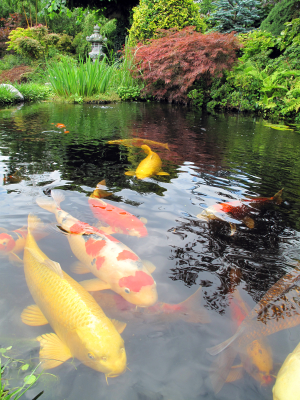 Koi colors. This appears to be the only way ornamental koi fish are classified. Just trying to understand all the colors can be almost overwhelming for a beginner, but with a little patience and study it all begins to make sense.
Koi colors. This appears to be the only way ornamental koi fish are classified. Just trying to understand all the colors can be almost overwhelming for a beginner, but with a little patience and study it all begins to make sense.
In English, the word ‘koi” refers only to the ornamental fish. In Japan, koi are symbols of love and friendship and this fish has become prized all over the world for its bright, vibrant colors. This type of fish is regarded as a symbol of friendship and love. As such, it has become extremely popular on everything from jewelry to tattoos.
Koi is simply the Japanese word for carp. It doesn’t matter if the fish is the grey colored variety used for food or a brightly colored ornamental fish gracing a landscaped and meticulously maintained backyard pond. They are both ‘koi’ in Japan. The only difference is of course, the color. And koi colors are what have made this fish become of great interest to collectors and breeders and a hugely profitable industry.
Koi colors are beautiful and original. Like people, no two koi fish are exactly the same. This uniqueness is what gives them the ability to impart calmness and serenity to people who just like to watch them. Different varieties are distinguished by color, patterns and scales. Every breeder actively looks for a new variety to develop.
It has been suggested that for a beginner to fully appreciate the beauty of koi, one needs to have an understanding of the Japanese terminology that describes the koi colors. For a novice, like myself, this can be a little overwhelming. After all, wikipedia lists more than twenty varieties and I have seen lists that had more than forty varieties. So I need a list to refer to. If I have a reference, then I don’t need to worry about terminology right away.
What I have noticed about Japanese terminology for koi colors is that there is often two or more words for the same color. One may refer to the basic skin color of the fish, and another to same color markings on a different color skin. For example, a koi with red skin can be called “aka” and red markings on a different color skin will be called “hi” or simply “hee”. Very confusing.
The beautiful and vibrant color is probably the reason most people become ornamental koi fish owners in the first place. After all, if the fish were not gorgeous, why would we want them in our pond. It is only later, after we have had koi for awhile that we begin to appreciate other attributes such as hardiness, size and longevity and of course, their individual personalities.
If you are interested in owning a koi of any color, my suggestion is to forget about the terminology, find a color you like and buy your koi. You will get hooked (no pun intended) and enjoy it for many years.